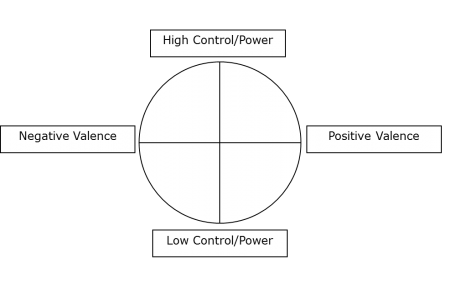The Geneva Emotion Wheel
The Geneva Emotion Wheel (GEW) is a theoretically derived and empirically tested instrument to measure emotional reactions to objects, events, and situations.
Format
The respondent is asked to indicate the emotion he/she experienced by choosing intensities for a single emotion or a blend of several emotions out of 20 distinct emotion families. The emotion families are arranged in a wheel shape with the axes being defined by two major dimensions of emotional experience:

Five degrees of intensity are being proposed, represented by circles of different sizes. In addition, "None" (no emotion felt) and "Other" (different emotion felt) options are provided.
References
The development of the GEW is described in the following documents, which you can download for private use:
Scherer, K. R. (2005). What are emotions? And how can they be measured? Social Science Information, 44(4), 693-727.
Scherer, K.R., Shuman, V., Fontaine, J.R.J, & Soriano, C. (2013). The GRID meets the Wheel: Assessing emotional feeling via self-report. In Johnny R.J. Fontaine, Klaus R. Scherer & C. Soriano (Eds.), Components of Emotional Meaning: A sourcebook (pp. 281-298). Oxford: Oxford University Press.
(2012). Geneva Emotion Wheel Rating Study. Unpublished report.
Conditions and recommendations for use
The GEW can be freely used for non-commercial research purposes. If you use the GEW or a modified version of it, please cite the instrument or its adaptation as follows: "…Geneva Emotion Wheel (GEW; see Scherer, 2005; Scherer, Fontaine, Sacharin, & Soriano, 2013). We appreciate receiving feedback and/or preprints/reprints of research work using the instrument.
To use the GEW, please download the recommended instructions and the response sheet which are provided in Word .docx format below. Versions in English, French and German are currently available.
Validated Chinese, Dutch, Estonian, Finnish, Italian, Japanese, and Polish language versions of the emotion terms within the wheel are also available. However, the instructions have not yet been translated and back-translated. We encourage researchers to produce translations of the instructions for these languages and grant the right to do so to qualified investigators with non-commercial research aims. Please contact us if you desire to develop a version of the GEW for another language than the ones mentioned above.
Please note that a licence is required for commercial applications of the GEW. For further information, please contact and specify your requirements.
We generally suggest to use the original version of the GEW as provided below and to not change the emotion family labels and their location around the wheel as these are based on empirical data and theoretical considerations. This will allow building a body of data that can be directly compared across different research groups, allowing for much needed replication in the area of emotion research (including cross-cultural comparison).
We realize that in some cases you might like to use the GEW format, but need to use other emotion terms to fit the purpose of your study. In that case, you can replace the standard labels by other terms. Please click here for further information.
Thank you very much for your interest in the Geneva Emotion Wheel.
Geneva Emotion Research Group
The development of this instrument has been supported by funds from the Gottlieb-Daimler- and Karl Benz-Foundation, Germany, the Swiss National Fund for Research, and the Swiss National Centre for Affective Sciences to Klaus Scherer.
Major contributions to the development of the GEW have been made by Véronique Tran, Pascal Edwards, Tanja Bänziger, Johnny Fontaine, Cristina Soriano, Olivier Rosset, Julien Savary, Franziska Tschan, Vera Sacharin, Katja Schlegel, and other members of the Swiss Center for Affective Sciences.
Downloads
